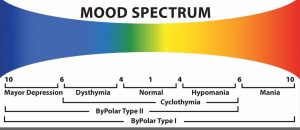 Danielle Johnson, MD, FAPA
Lindner Center of HOPE/Chief Medical Officer
University of Cincinnati College of Medicine Adjunct Assistant Professor of Psychiatry
Danielle Johnson, MD, FAPA
Lindner Center of HOPE/Chief Medical Officer
University of Cincinnati College of Medicine Adjunct Assistant Professor of Psychiatry
Medications are undoubtedly an important tool in the treatment of mental illnesses. Expert application of psychopharmacology is a game changer in improving symptoms of mental illness and helping individuals achieve a manageable baseline. Complex co-morbidities and severe mental illness make prescribing even more complex.
Psychiatric medications can stabilize symptoms and prevent relapse. They work by affecting neurotransmitters in the brain. Serotonin is involved in mood, appetite, sensory perception, and pain pathways. Norepinephrine is part of the fight-or-flight response and regulates blood pressure and calmness. Dopamine produces feelings of pleasure when released by the brain reward system.
One in ten Americans takes an antidepressant, including almost one in four women in their 40s and 50s. Women are twice as likely to develop depression as men.
Selective Serotonin Reuptake Inhibitors (SSRIs) Side Effects
Selective serotonin reuptake inhibitors (SSRIs) increase levels of serotonin. Fluoxetine (Prozac), paroxetine (Paxil), sertraline (Zoloft), fluvoxamine (Luvox), citalopram (Celexa), and escitalopram (Lexapro) treat depression, anxiety disorders, premenstrual dysphoric disorder, eating disorders, and hot flashes. Potential side effects include jitteriness, nausea, diarrhea, insomnia, sedation, headaches, weight gain, and sexual dysfunction.
Zoloft Side Effects in Women
Zoloft, also known by its generic name sertraline, is an antidepressant medication that can cause a range of side effects in women. Some of the common side effects of Zoloft include nausea, diarrhea, headache, dizziness, dry mouth, drowsiness, and difficulty sleeping. Women may also experience sexual side effects such as decreased libido, difficulty reaching orgasm, and erectile dysfunction. In some cases, Zoloft may cause weight gain or weight loss, and it can also affect blood pressure and heart rate. Rare but serious side effects of Zoloft in women may include seizures, serotonin syndrome, and suicidal thoughts or behavior.
Prozac Side Effects in Women
Prozac, also known by its generic name fluoxetine, is an antidepressant medication that can cause a range of side effects in women. Some of the common side effects of Prozac include nausea, diarrhea, headache, dizziness, dry mouth, drowsiness, and difficulty sleeping. Women may also experience sexual side effects such as decreased libido and difficulty reaching orgasm. Prozac may also cause weight gain or weight loss, and it can affect blood pressure and heart rate. Rare but serious side effects of Prozac in women may include serotonin syndrome, suicidal thoughts or behavior, and seizures.
Lexapro Side Effects in Women
Lexapro, also known by its generic name escitalopram, is an antidepressant medication that can cause a range of side effects in women. Some of the common side effects of Lexapro include nausea, diarrhea, headache, dizziness, dry mouth, drowsiness, and difficulty sleeping. Women may also experience sexual side effects such as decreased libido and difficulty reaching orgasm. Lexapro may also cause weight gain or weight loss, and it can affect blood pressure and heart rate. Rare but serious side effects of Lexapro in women may include serotonin syndrome, suicidal thoughts or behavior, and seizures.
Serotonin-norepinephrine Reuptake Inhibitors (SNRIs) Side Effects
Serotonin-norepinephrine reuptake inhibitors (SNRIs) increase levels of serotonin and norepinephrine. Venlafaxine (Effexor), duloxetine (Cymbalta), and desvenlafaxine (Pristiq) are used to treat depression, anxiety disorders, diabetic neuropathy, chronic pain, and fibromyalgia. Potential side effects include nausea, dry mouth, sweating, headache, decreased appetite, insomnia, increased blood pressure, and sexual dysfunction.
Tricyclic Antidepressants Side Effects
Tricyclic antidepressants (TCAs) also increase serotonin and norepinephrine. Amitriptyline (Elavil), clomipramine (Anafranil), desipramine (Norpramin), nortriptyline (Pamelor), doxepin (Sinequan), trimipramine (Surmontil), protriptyline (Vivactil), and imipramine (Tofranil) are used to treat depression, anxiety disorders, chronic pain, irritable bowel syndrome, migraines, and insomnia. Possible side effects include sedation, forgetfulness, dry mouth, dry skin, constipation, blurred vision, difficulty urinating, dizziness, weight gain, sexual dysfunction, increased seizure risk, and cardiac complications.
Other Antidepressants Side Effects
Wellbutrin Side Effects in Women
Bupropion (Wellbutrin) increases levels of dopamine and norepinephrine. It treats depression, seasonal affective disorder, ADHD, and can be used for smoking cessation. It can also augment other antidepressants. Potential side effects include anxiety, dry mouth, insomnia, and tremor. It can lower the seizure threshold. There are minimal to no sexual side effects or weight gain.
Trazodone (Desyrel, Oleptro) affects serotonin and mirtazapine (Remeron) affects serotonin and norepinephrine. They are both used for depression and sleep. Mirtazapine has minimal sexual side effects.
Monoamine oxidase inhibitors (MAOIs) increase serotonin, norepinephrine, and dopamine. Isocarboxazid (Marplan), phenelzine (Nardil), selegiline (Emsam), tranylcypromine (Parnate), and moclobemide are associated with more serious side effects than other antidepressants. There are dietary restrictions and numerous drug interactions. MAOIs are often used after other antidepressant classes have been tried. Other antidepressants need to be discontinued for a period of time prior to starting an MAOI.
Newer antidepressants include Viibryd (vilazodone) which affects serotonin, Fetzima (levomilnacipran) which affects serotonin and norepinephrine, and Brintellix (vortioxetine) which affects serotonin. Brintellix and Viibryd have mechanisms of action that make them unique from SSRIs. Viibryd is less likely to cause sexual side effects.
Excess serotonin can accumulate when antidepressants are used with other medications that effect serotonin (other antidepressants, triptans for migraines, certain muscle relaxers, certain pain medications, certain antinausea medications, dextromethorphan, St. John’s Wort, tryptophan, stimulants, LSD, cocaine, ecstasy, etc.) Symptoms of serotonin syndrome include anxiety, agitation, restlessness, easy startling, delirium, increased heart rate, increased blood pressure, increased temperature, profuse sweating, shivering, vomiting, diarrhea, tremor, and muscle rigidity or twitching. Life threatening symptoms include high fever, seizures, irregular heartbeat, and unconsciousness.
Estrogen Levels With Antidepressants in Females
Varying estrogen levels during the menstrual cycle, pregnancy, postpartum, perimenopause, and menopause raise issues with antidepressants and depression that are unique to women. Estrogen increases serotonin, so a decrease in estrogen at certain times in a woman’s reproductive life cycle can reduce serotonin levels and lead to symptoms of depression. Hormonal contraception and hormone replacement therapy can reduce or increase depressive symptoms; an increase in symptoms may be more likely in women who already had major depressive disorder. During pregnancy, antidepressants have a potential risk to the developing baby but there are also risks of untreated depression on the baby’s development. With breastfeeding, some antidepressants pass minimally into breast milk and may not affect the baby. The benefits of breastfeeding may outweigh the risks of taking these medications. Antidepressant sexual side effects in women are vaginal dryness, decreased genital sensations, decreased libido, and difficulty achieving orgasm. Women should communicate with their psychiatrist and/or OB/GYN to discuss the risks and benefits of medication use vs. untreated illness during pregnancy and breastfeeding; the use of hormonal treatments to regulate symptoms associated with menses and menopause; and the treatment of sexual dysfunction caused by antidepressants.
It has been observed that some antidepressants can affect estrogen levels in women. For instance, selective serotonin reuptake inhibitors (SSRIs) such as fluoxetine (Prozac) and sertraline (Zoloft) have been shown to decrease estrogen levels in women. On the other hand, other antidepressants such as venlafaxine (Effexor) and duloxetine (Cymbalta) have been shown to increase estrogen levels. The exact mechanisms behind these effects are not fully understood, but it is thought to be related to the interactions between the medication and the hypothalamic-pituitary-gonadal (HPG) axis, which is responsible for regulating estrogen production. It is important for women to discuss any potential effects of antidepressants on estrogen levels with their healthcare provider, especially if they have a history of hormonal imbalances or are taking hormonal therapies.
It is important for women to discuss any potential side effects with their healthcare provider before starting any depression medication.
Lindner Center of HOPE’s Approach
Lindner Center of HOPE’s residential services employ full-time psychiatrists with expertise in psychopharmacology. These prescribing physicians are designated members of each residential client’s treatment team. Medication management within Lindner Center of HOPE’s residential programs is also supported by 24/7 psychiatry and nursing staff, onsite pharmacy and an innovative Research Institute.
In some cases, patients over the course of treatment for mental illnesses accumulate many prescriptions. In cases like this, Lindner Center of HOPE’s residential units can offer a safe environment for medication assessment and adjustment. While the client participates in appropriate evaluation and treatment, their psychiatrist can also work with them on reaching rational polypharmacy — in other words, medication optimization.
For patients with more severe, treatment-resistant mental illness, Lindner Center’s psychiatrists can implement the most complicated, and often hard to use, treatments, in a safe environment, while under their observation.
If medication adjustments result in decompensation on the residential units, a patient can be temporarily stepped up to an acute inpatient unit on the same campus.














 Nicole Bosse, PsyD
Nicole Bosse, PsyD